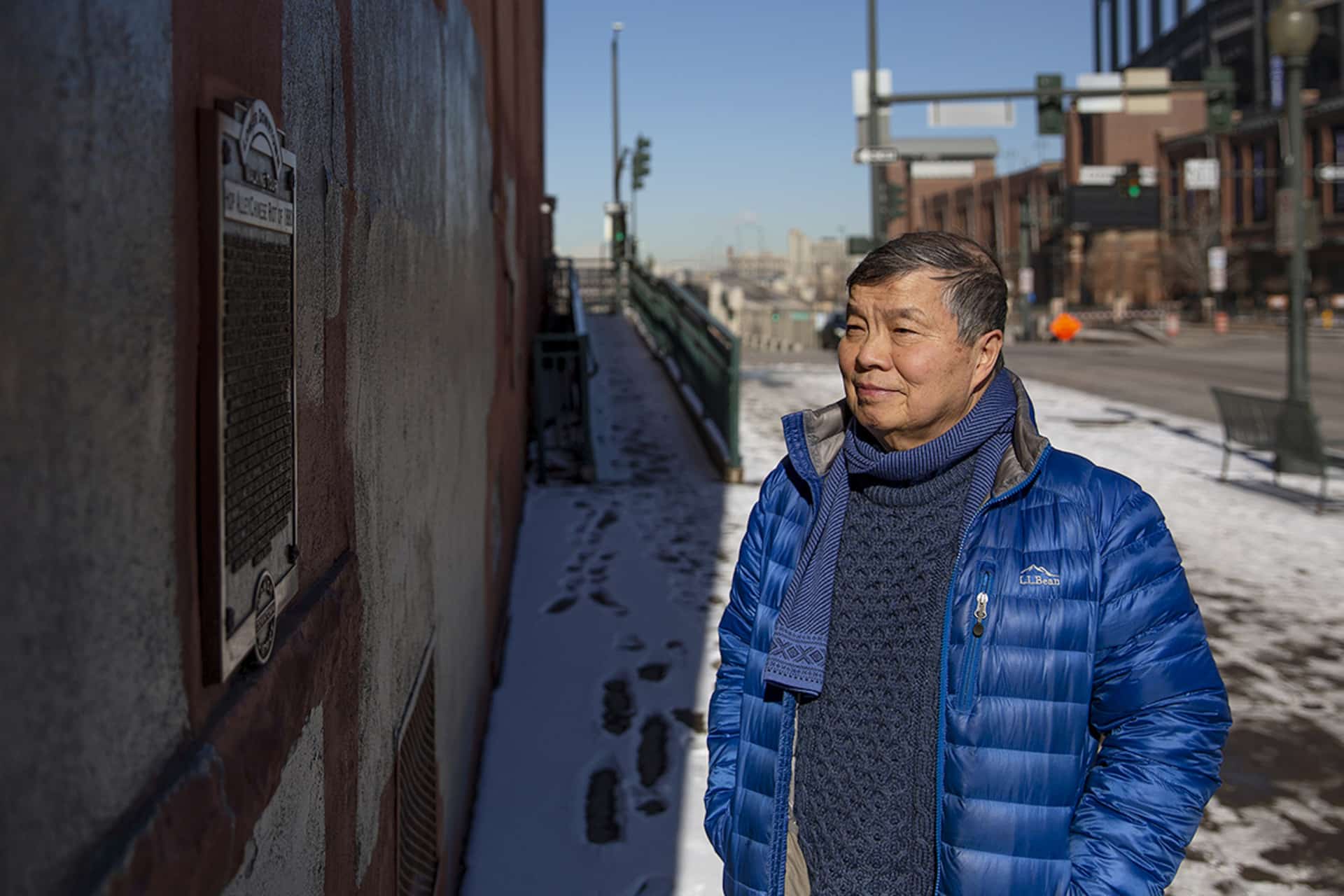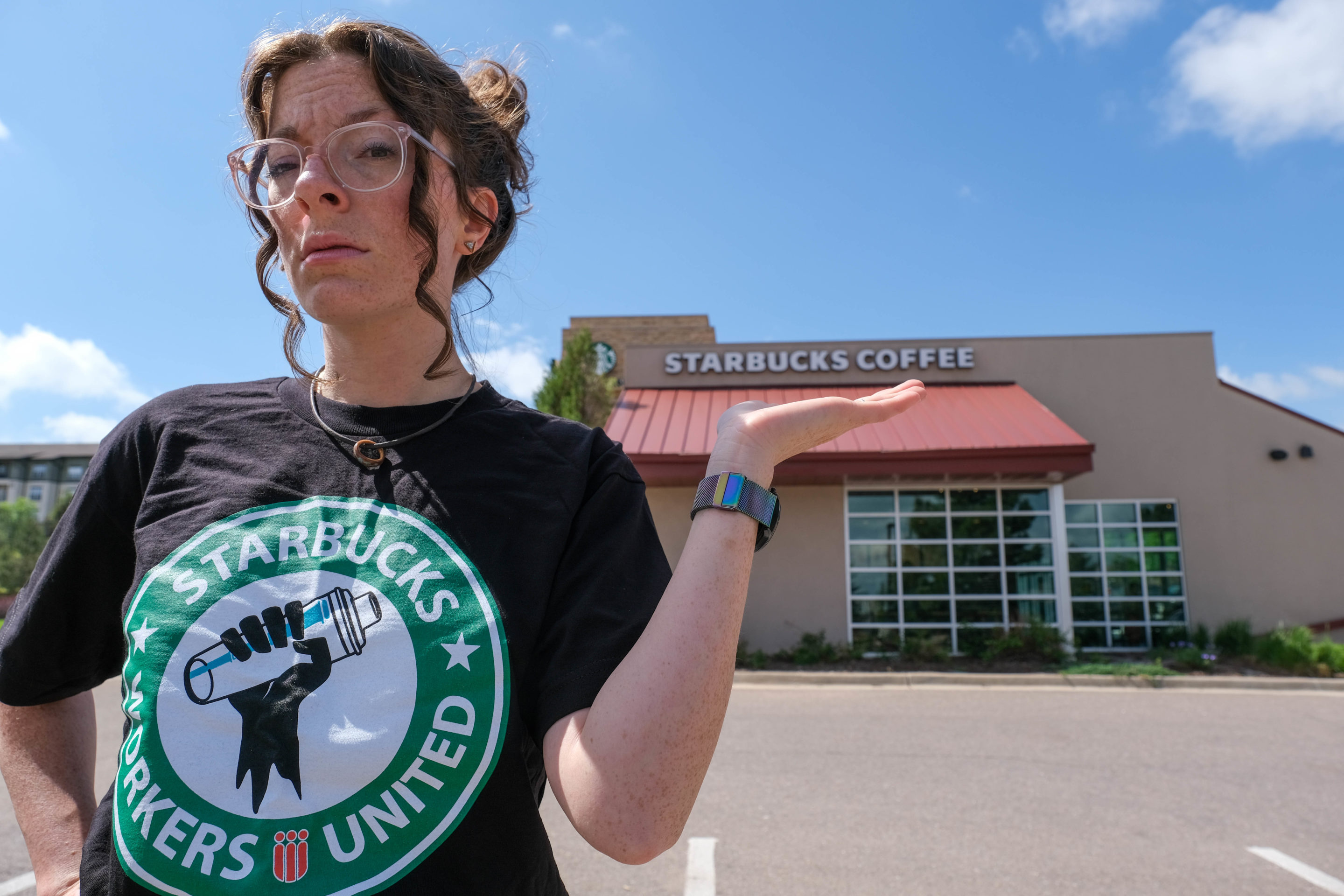//William Wei, Ph.D., stands in front of the plaque that is being changed by the end of the year due to racist wording at 20th and Blake Streets on Feb. 16. Photo by Polina Saran | [email protected]
At the corner of 20th and Blake Streets sits a commemorative plaque with several historical inaccuracies.
The plaque memorializes an anti-Chinese riot that destroyed Denver’s Chinatown, calling the event a “Chinese riot.” But it erases the primary victim of the Sinophobic attack, according to historians and activists. Were it to read in full, they say, it would state that on Oct. 31, 1880, Lu Yang, also called Look Young or in his native language 陆扬, was lynched by anti-Chinese rioters.
On Lunar New Year, the Denver Asian American and Pacific Islander Commission released a video announcing the replacement of the plaque along with an ambitious project to reimagine and rebuild Denver’s Chinatown. The endeavor will take upwards of a decade to complete but will soon begin in earnest.
“What started as a simple task to revise the wording of a historically inaccurate plaque has now grown into a quest to re-envision this history and to celebrate an Asian presence in Denver,” said William Wei, professor of history at University of Colorado Boulder,in the video. “We’re reaching out to all of you who may be interested in taking this journey with us.”
The video goes on to invite all Coloradans to join for a virtual community town hall on Feb. 27 at 10 a.m. to discuss short and long-term goals.
As the 2019 to 2020 state historian, Wei believes that revealing the misunderstood history of Denver’s past is a crucial step in creating a more harmonious future. His point carries added significance as in the last year hate crimes against Asian Americans increased in some parts of the country by as much as 1900%.
“The current Denver Chinatown plaque dehumanizes them,” Wei said. “That’s how discrimination continues. We need to make our history more accurate.”
Wei and the DAAPIC’s grievances with the current plaque, titled “Hop Alley/Chinese Riot of 1880,” are numerous. Namely, Denver’s Chinatown began at 17th and Wazee Streets, not at 20th and Blake Streets where the commemoration now resides.
The description briefly portrays the Chinese immigrants who came as railway workers but quickly devolves into characterizing the area as a den of prostitution and drug use. The inscription clearly depicts the names and actions of the white saviors during the riot but is vague on the riot’s impetus and omits Lu Yang’s name and story. Instead, the sign simply states that “one Chinese man lost his life.”
“It doesn’t focus much on any of the folks that lived there, any of the culture that was there,” said the commission’s Vice-Chair Joie Ha. “Not to say that the Caucasian people weren’t brave but the focus is completely missed on what is the most important thing—that there was a thriving Chinatown, there was an anti-Chinese riot, they had destroyed all the businesses and they had killed a man and lynched him.”
On the riot’s 140 year anniversary, Mayor Michael Hancock designated Oct. 31 as “Denver’s Chinatown Commemoration Day.” With this precedent set, Ha is confident that the replacement of the plaque along with an addition of a corresponding mural will be completed before the end of the year.
However, the commission’s plans extend far beyond 2021. A team is assembling for the long-term pursuit of creating an Asian district in the area that used to be Chinatown. The tentative plans include traditional Chinese-style archways, Asian food vendors, and a modern museum revealing the history of Denver’s AAPI community.
Around the time that DAAPIC began discussing the plaque, architect at Shopworks Architecture Adam Buehler and Creative Director of Niam designs Ben Niamthet were also engaging in a similar dialogue. Eventually, they reached out to the commission to put words into action. They’re now engaged with the revitalization project from the ground up.
“Both of us are really interested in design and architecture that has a positive community purpose,” said Buehler. “People have a low, low appetite and attention span for history so we want to encourage spontaneous involvement. We want history to pop up.”
Buehler and Niamthet are intimately aware of how neighborhoods change and evolve. Buehler points to gentrification as proof of what happens when neighborhoods change without a socially conscious mindset. He imagines the reenvisioning of Chinatown as a way to direct this evolution.
With the alley that was once the center of Chinatown being in the heart of Lo-Do, the group hopes this to be an area where people come to eat before and after attending Rockies games or visiting the River North neighborhood.
But, Niamthet is clear that this district will not be a tourist stop projecting the old worn tropes of Asian exoticism. He plans on including traditional Asian architecture and features like paper lanterns while also illustrating an image of modernity.
“With murals, it will be more cohesive with showing the past and the future of Asian Americans,” Niamthet said. “We’ve been here as long—or if not before the European immigrants—so it’s not like we just got off the boat. And then, what does that mean to the future of America? We’re going to be part of that through and through.”
Niamthet imagines rotating murals by local AAPI artists that visitors to the museum will be able to take photos of for social media. He envisions modern buildings made of traditional materials and facades that honor history. But, he doesn’t plan to make the district lined with pagodas. “We don’t live in huts anymore. We look back just to learn from it but then spring forward.”
This desire for a synthesis between the past and present is shared by DAAPIC Chair and food truck owner Shauna Medeiros-Tuilaepa. She hopes the alley’s restaurants show the same courtesy. While her food truck, No Ke Aloha, has fusion food she makes certain that her traditional Hawaiian and Polynesian culture is preserved.
“Food and culture tend to get watered down as they become more Americanized,” Medeiros-Tuilaepa said. “It’s really important to be able to evolve but to also have your roots. Being able to have authenticity of different styles of cuisines in Denver not only is going to provide a sense of representation throughout the AAPI community, but it also allows our culture and our history to be shared with our counterparts.”
DAAPIC Commissioner and journalist Gil Asakawa also believes the district will provide Asian Coloradans with a chance to learn their own history. As a young man in Denver, he felt duped for being taught incomplete historical narratives.
“This plaque reflects the fact that history is written by people who are in power and in this country they are European Americans,” Asakawa said. “I live and breathe Asian community and history and identity and I had no idea. It occurred to all of us that we need to find ways to celebrate this lost history.”
All members of the team acknowledge that these plans are a monumental change to an integral Denver area. They are realistic about the time it will take and the small footholds that need to be reached before their dream is realized.
And yet, despite a sheer cliff face standing before them, they seem optimistic and willing to grapple for a chance to share one of the many invisible histories of Denver.
“The story I want this district to tell is that Asians, particularly Chinese immigrants, made their way here despite a lot of odds and found their way to settle and make a living,” Asakawa said. “The history of America is that story. It’s a horrible cliche because it’s usually not right, but that cliche American dream. People come to this country because of the lure of that dream.”
For now, plans are being laid, connections are being formed, resources are being gathered, and to start it all off, one man is being named.
We hope you enjoyed this article! Did you know you can support your local press for FREE by becoming a member? Subscribe today.





Great informative article. It’s never too late to correct errors.